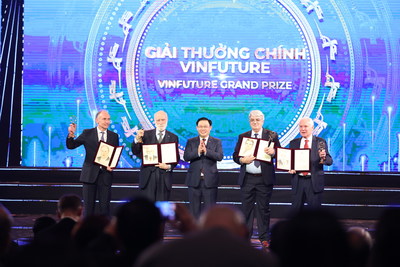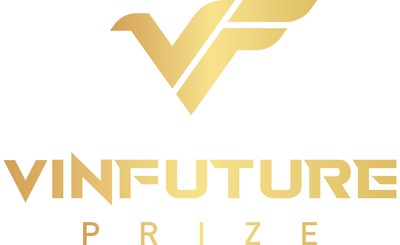HANOI, Vietnam, Dec. 21, 2022 /PRNewswire/ — Today, the VinFuture Prize Council announced the 2022 VinFuture Prize winners – scientists whose breakthrough research projects are exceptional scientific accomplishments that positively impact the lives of billions of people on Earth now and in the future. They represent major advancements in science and technology that will reshape all aspects of life and promote sustainable development for humanity.

Attracting 970 nominations from over 70 countries across six continents, the four most outstanding scientific works, aligned with this season’s theme of “Reviving and Reshaping”, were chosen as the winners.
They include: the breakthroughs that have made global network technology a reality; 3D protein structure prediction using AI system AlphaFold 2; isolation of the Sub1A gene that facilitated the development of submergence tolerant rice; and a low-cost filtration system to remove arsenic and other heavy metals from groundwater.
Grand Prize
The Grand Prize, valued at US$3 million, was awarded to Sir Timothy John Berners-Lee, Dr. Vinton Gray Cerf, Dr. Emmanuel Desurvire, Dr. Robert Elliot Kahn and Professor Sir David Neil Payne for their breakthroughs in making global network technology a reality, forever changing the way we live, communicate, and work and laying the foundation for modern socio-economic progress and future technological innovations.
Sir Timothy John Berners-Lee invented the World Wide Web, wrote the first web browser, and led the design and establishment of three critical internet standards including HTML, HTTP, and URLs. These have enabled the seamless sharing and use of information resources across the global internet.
Dr. Vinton Gray Cerf and Dr. Robert Elliot Kahn led the design and implementation of the Transmission Control Protocol and Internet Protocol (TCP/IP) which are the basis for the functioning of today’s internet.
Current global network technology relies on optical fiber communication, the development of which was enabled by the work, over five decades, of Sir David Neil Payne. His work related to fiber design, optical amplifiers, specialty fibers, and high-power lasers and amplifiers, together with the breakthrough work of Emmanuel Desurvire on Erbium-doped fiber amplifiers, made internet transmission possible on a global scale, thanks to their ability to boost high-speed optical signals repeatedly.
This ground-breaking research on global network technology is the result of numerous layers of invention, allowing all forms of information to be reliably communicated, transferred, and shared at the speed of light. This has enabled real-time interaction, collaboration, and co-creation between individuals and groups across the world. The impacts of these inventions are both transcontinental and transoceanic. From fiber-to-the-home and enterprise communications, they affect all aspects of our world including society, government, economics, security, and defense.
Special Prizes
In addition to the Grand Prize, three Special Prizes, each valued at US$500,000, have been awarded to innovators in emerging fields, female innovators, and innovators from developing countries.
The Special Prize for “Innovators with Outstanding Achievements in Emerging Fields” was awarded to Dr. Demis Hassabis and Dr. John Jumper for their pioneering work on AlphaFold 2, an artificial intelligence program that has revolutionized the modeling of protein structures, accelerating advances in biomedicine, health, and agriculture.
The problem of determining protein structures is central to enabling a fundamental understanding of cellular processes, developing new drugs, proposing new synthetic biology, and numerous other applications.
Dr. Demis Hassabis conceived a solution to this problem through deep learning, assembling the pioneering DeepMind team, on which Dr. John Jumper was the lead scientist. Together, they reduced what previously took years of work to mere hours, accelerating progress on some of the most important problems in biomedicine and health, agriculture, sustainability, and beyond. The team made openly available a database of the structures of over 200 million proteins, enabling the public to benefit from their work and helping thousands of scientists tackle problems across the world.
The Special Prize dedicated to “Female Innovators” was awarded to Professor Pamela Christine Ronald for her breakthroughs in isolating the Sub1A gene which facilitated the development of submergence tolerant rice varieties, helping feed millions of people in South and Southeast Asia. In this region of the world, four million tons of rice enough to feed 30 million people is lost to flooding each year.
Professor Ronald and team showed that expression of the single rice gene Sub1a is sufficient to confer submergence tolerance. This discovery facilitated the development of new varieties of rice by breeders at the International Rice Research Institute The new Sub1 varieties have a 60% yield advantage compared to conventional varieties following floods. The new varieties of submergence tolerant rice are helping farmers in countries affected heavily by flooding, which is occurring with increasing duration and frequency in the changing climate.
The Special Prize dedicated to “Innovators from Developing Countries” was awarded to Professor Thalappil Pradeep for his development of a low-cost filtration system to remove arsenic and other heavy metals from groundwater, helping hundreds of millions of people around the world living with contaminated water get access to clean water.
Safe water is the most important enabler of life and is central for socio-economic development.
To mitigate the health hazards of using water contaminated by arsenic, iron and other metals, a long-standing problem particularly in North India, Professor Pradeep discovered affordable and sustainable nanomaterials which could be used to them to produce clean water. The arsenic and other materials removed by these materials do not cause impact on the surrounding environment. This method, employing simple designs, provides a means to purify groundwater at a very low cost to reach millions of impacted households. In remote areas, this technology is even more advantageous because it does not require electricity.
Far exceeding the Prize Council’s expectations on the quantity, quality, applicability, and practical impacts of nominations, the second season of the VinFuture Prize and the VinFuture Award Ceremony 2022, specifically, have helped affirm Vietnam’s position and scientific reputation in the eyes of the global scientific community. The prize laureates have developed innovative scientific projects and technologies focused on fostering meaningful change and bringing diverse and exceptional advancements to humanity with the goal of building a flourishing, equitable, and sustainable world.
The third cycle of the VinFuture Prize has now started, immediately following the conclusion of the 2022 VinFuture Prize Award Ceremony. After concluding the mission of revival and reshaping, VinFuture Prize 2023 will aim to honor scientific and technological inventions or initiatives that contribute to building a “resilient and revolutionary” world. The VinFuture Prize will officially call for nominations starting 7:00 am (EST) January 9th and running until 7:00 am (EST) on May 15th, 2023.

SOURCE VinFuture Foundation
















